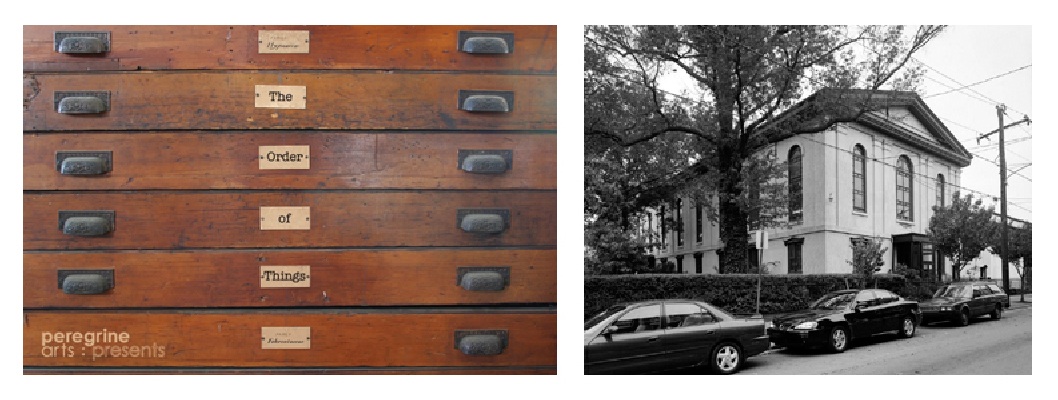
THE ORDER OF THINGS
FEBRUARY 24 + 25, 2007
Wagner Free Institute of Science
THE ORDER OF THINGS invites visitors into an ethereal and seductive sound-scape that explores our relentless quest for order, from the private sphere to the vast domains of the natural world. This world premiere piece by British sound artist Scanner (a.k.a. Robin Rimbaud) will feature an electro-acoustic installation and 45-minute performance inspired by and created for the breathtaking space of The Wagner Free Institute of Science. Scanner’s work will celebrate the tercentenary of Swedish biologist Carolus Linnaeus, who was the father of modern taxonomy. The Wagner Free Institute of Science is home to a collection of 100,000 natural history specimens displayed in their original Linnaean ordering, one of the largest systematically arranged collections on display in the country, providing a rare view of a Victorian science museum. The installation will explore various ideas of order, not only as they relate to the legacy of Linnaeus, but also as they concern our contemporary scientific worldview.
THE WAGNER FREE INSTITUTE OF SCIENCE
1700 West Montgomery Avenue, Philadelphia PA 19121
(Park secure at the Liacouras Center, N. 15th Street at Cecil B. Moore.)
FEBRUARY 24 + 25, 2007
Schedule for both days:
2:00 ~ 3:00 p.m.: installation open
3:00 ~ 3:45 p.m.: performance by Scanner
4:00 ~ 5:00 p.m.: reception in the installation space
$30 Adults / $20 Wagner Members / $10 Students (w/ ID) + Seniors (65+)
ENTRANCE FREE for Temple University students with valid ID
TO PURCHASE TICKETS
Visit our website at www.peregrinearts.org
FOR MORE INFORMATION: CALL 215 760 1634 or e-mail theorderofthings@peregrinearts.org
Robin Rimbaud (a.k.a. “Scanner”) (scannerdot.com) traverses the experimental terrain between sound, space, image and form, creating absorbing, multi-layered sound pieces that twist technology in unconventional ways. A true renaissance artist of digital pop culture, from his earliest controversial work using found mobile phone conversations, through to his focus on trawling the hidden noise of the modern metropolis as the symbol of the place where hidden meanings and missed contacts emerge, his restless explorations of the experimental terrain have won him international admiration from amongst others, Bjork, Aphex Twin and Stockhausen. Since 1991 he has been intensely active in sound art, producing concerts, compositions, installations and recordings. The albums Mass Observation (1994), Delivery (1997), and The Garden is Full of Metal (1998) have been hailed by critics as innovative and inspirational works of contemporary electronic music. He has performed and created works in many of the world’s most prestigious spaces including SFMOMA USA, Hayward Gallery London, Centre Pompidou Paris, Tate Modern London, Palais des Beaux-Arts Lille, Kunsthalle Vienna, Bolshoi Theatre Moscow, Hanoi Opera House Vietnam and the Royal Opera House London. His work can also be heard on permanent display in the Science Museum London (“Sound Curtains”) and the Raymond Poincare hospital in Garches, France as part of the bereavement suite (“Channel of Flight”).
The Wagner Free Institute of Science’s (wagnerfreeinstitute.org) nineteenth century exhibit hall — a soaring three-story space — houses an extraordinary collection of natural history specimens including mounted birds and mammals, fossils, rocks and minerals, insects, shells, dinosaur bones, and the first American saber-toothed tiger, discovered on a museum-sponsored expedition to Florida in 1886. Gathered largely by founder William Wagner and Institute curators and faculty during the nineteenth century, the collections are displayed in cherry-wood and glass cabinets dating from the 1880s and maintain their original “systematic” scheme, providing a rare view of a Victorian science museum. Highlights include William Wagner’s personal mineral collection — one of the oldest in the country — and his fossil collection, representing many important European and American localities and collecting sites of the nineteenth century. The mounted skeletons, skulls and skins represent species from around the globe, including many that are now endangered. The extensive regional entomology collection is notable for its arrangement, which includes the original handwritten curator’s labels. Originally assembled to teach science, the specimens are arranged for study. The exhibit is one of the largest systematically arranged collections on display in the country and remains in active use as a key educational tool of the Institute’s free science programs. It also serves as a resource for scholarly research.
